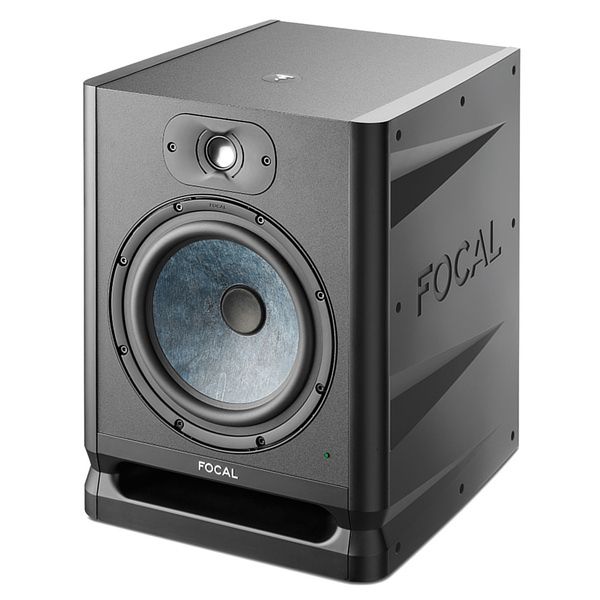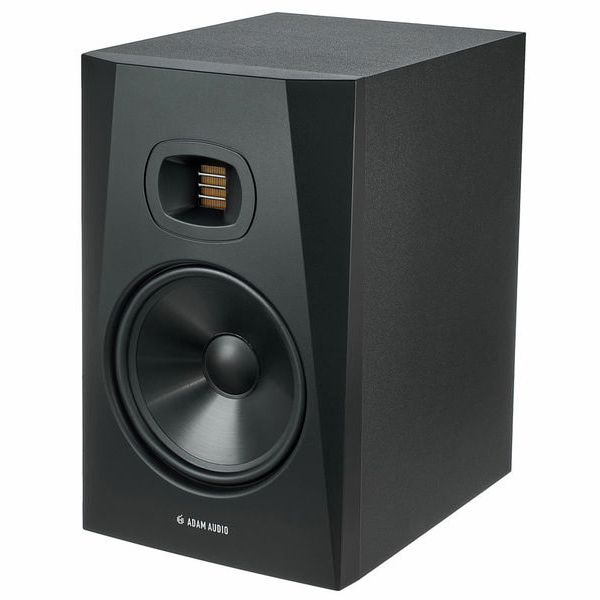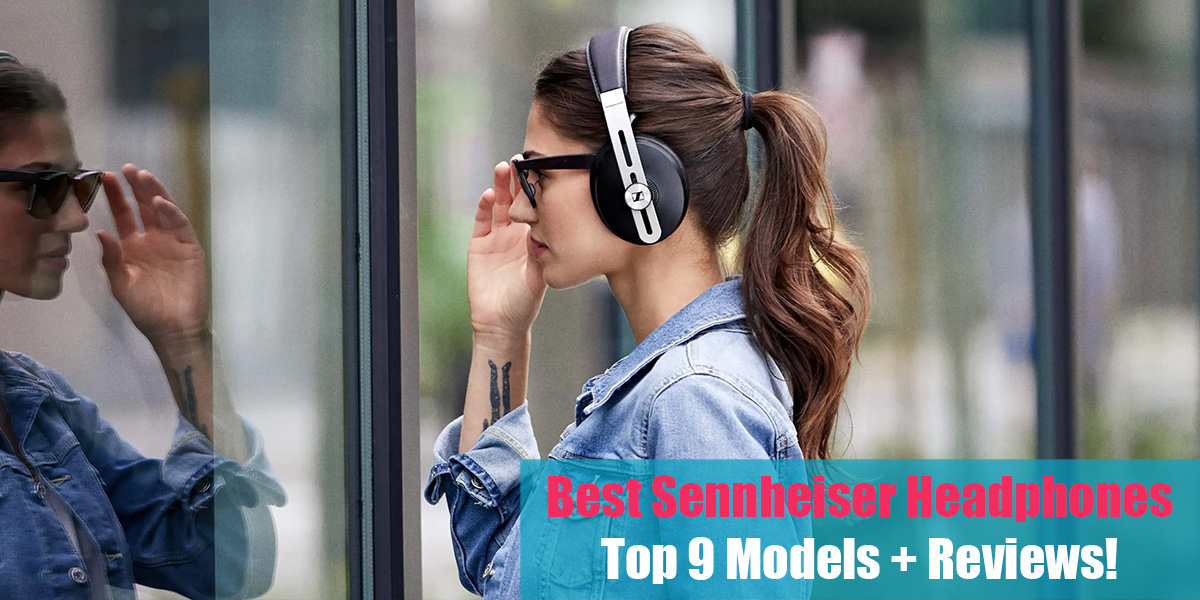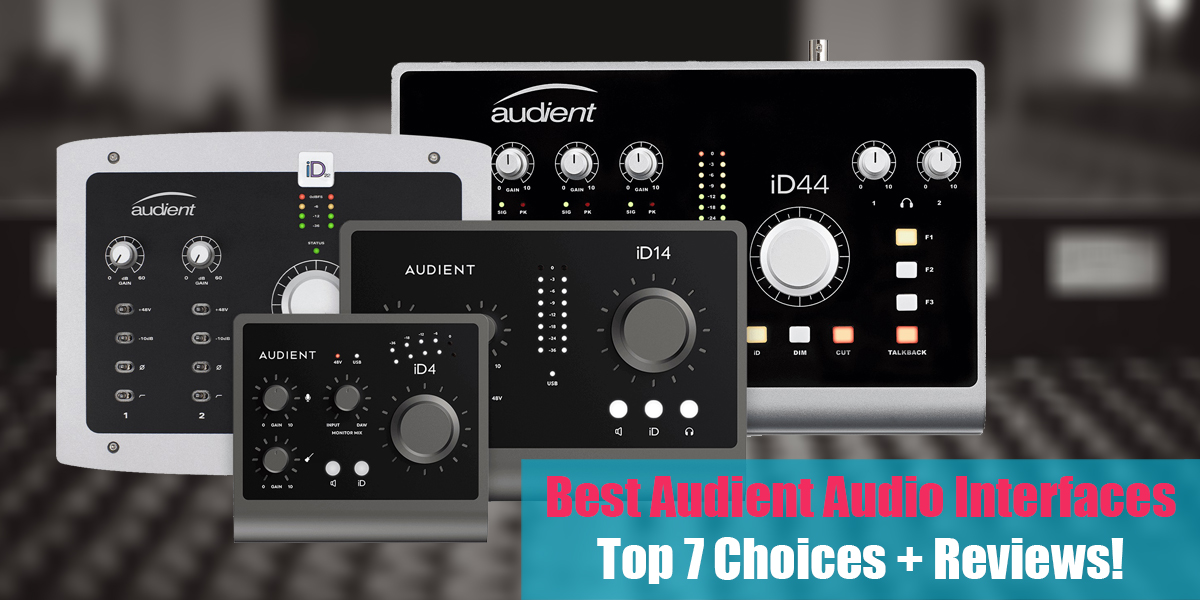Best 8 Inch Studio Monitors
Introduction
If you have a large studio room, you’ll likely need bigger studio monitors as well. Choosing the right monitor size mainly depends on your needs and the overall size of your room. To adequately fill a big space with sound, you should aim for at least 8-inch studio monitors.
If you already own smaller speakers and try using them in a larger room, you’ll quickly notice they’re not enough. You’ll miss out on the full power of your music, and the bass response will feel weak—leaving your productions sounding incomplete. In the end, you’ll realize that what you’re really missing is a larger studio monitoring system.
In this article, we’re going to cover what we think are the best 8-inch studio monitors available. These choices offer great sound quality, accurate frequency response, and are most likely active monitors. We won’t be discussing passive speakers this time; we’ll save that topic for another day.
We’ll start with our selection and a brief review of each model. Just a note: the monitors are not listed in any particular order, as we don’t want to rank one as the absolute best over another. Let’s get started!
1. Yamaha HS8
Although the Yamaha HS8s might be the best option from Yamaha’s HS line, they aren’t perfect. In addition to having overhyped highs and scooped mids, they also have a noticeably “smiley” frequency response. This makes them better suited as secondary reference monitors rather than your main pair.
The Yamaha HS8 offers a frequency response from 38 Hz to 30 kHz. Even without a subwoofer, this range should be enough for any producer to create a complete sound image. However, the highs tend to be exaggerated, and the low mids can feel a bit lacking.
The sound from these monitors is very clean—almost too clean for some people’s tastes. They might not be ideal as your primary monitors, but if you’re looking for an “in-reality” reference check, they could be useful. Think of them like a car stereo or a midrange home system. If that appeals to you, give these a try.
Their 120W amplification makes them quite loud. We didn’t notice any hiss or distortion, but it could be worth buying from a local seller in case you want to exchange them if you encounter any problems.
Since these monitors are quite heavy, they’re not ideal for a mobile setup. As Yamaha speakers, they have the simple and elegant look we’ve come to expect from the brand over the years.
They’ll look good in any studio. Their size shouldn’t be an issue either, since you can adjust them with the room control switches. Overall, they’re a solid choice if you’re just getting into music production, especially since they won’t break the bank.
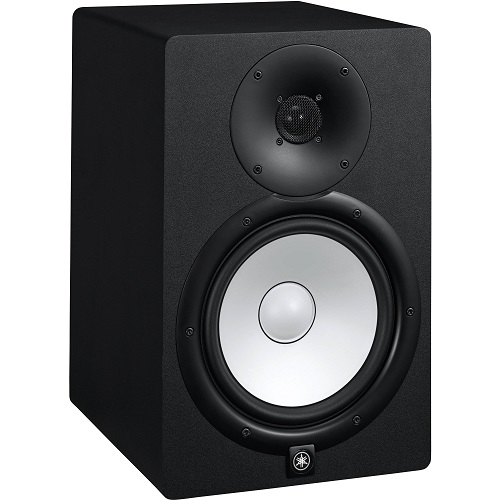
- Active 2-Way Nearfield Monitor
- 8″ Woofer (75 W) + 1″ Tweeter (45 W)
- Power: 120 W biamp
- Bass reflex system
- Frequency range: 38 Hz – 30,000 Hz
- Inputs: balanced XLR and 6.3 mm balanced jack
| IMAGE | PRODUCT | For US Customers |
For EU Customers |
Amazon Store |
|---|---|---|---|---|
Yamaha HS8 |
2. KRK Rokit 8 G3
KRK has released a new generation of ROKIT monitors with the ROKIT 8″ G3. The ROKIT series, first introduced in the mid-2000s, is KRK’s popular line of studio monitors. KRK has been making studio monitors since the 1980s.
One of the first things you’ll notice about these monitors is the black and yellow aramid glass composite speaker cone. Aramid, commonly known as Kevlar, is strong and heat-resistant, making it a great material for speaker cones. Most studio monitors also feature a 1″ soft dome tweeter at the top.
With a frequency response of 35 Hz to 35 kHz, these monitors are perfect for producers working in any genre. On the back, you’ll find switches to adjust the high and low frequencies by 1 or 2 decibels—handy if your room has some sound issues.
The back panel also includes XLR, 1/4-inch jack, and RCA connections. This variety of input options is useful if you’re connecting to a mixer or audio interface with specific output connections.
If your setup allows open space under the woofer, the front port (the open area beneath it) can be beneficial. Keep in mind that rear-ported speakers can sound very different if placed too close to a wall.
Overall, this is a solid mid-range studio monitor for the price. For producers just starting out, KRK ROKITs are a great way to kickstart their careers.
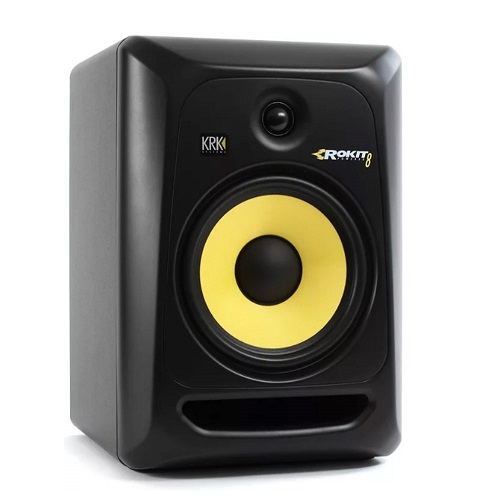
- Power Configuration: Bi-amped
- Quantity: Single
- LF Driver Size: 8″ Woofer
- LF Driver Type: Glass Aramid
- HF Driver Size: 1″ Tweeter
- HF Driver Type: Soft Dome
- Frequency Range: 35Hz-35kHz
| IMAGE | PRODUCT | For US Customers |
For EU Customers |
Amazon Store |
|---|---|---|---|---|
KRK Rokit 8 G3 |
3. Kali Audio LP-8
Kali Audio is one of the world’s top manufacturers of studio monitors, consistently delivering outstanding speakers. The LP-8 Kali studio monitor is no exception. Designed to achieve a 3D soundstage, this speaker features a special 3-D imaging waveguide.
With the Kali LP-8, you’ll be able to make critical decisions about your mixes as you listen. It’s equipped with a powerful 40W dome tweeter that delivers clear, articulate sound. Plus, the LP-8 offers both LF and HF trim controls, ensuring you get the best possible sound quality no matter what room you’re in.
The sound quality is impressive—you’ll easily detect flaws in your mix, and you won’t waste hours fixing issues that aren’t really there. Because these monitors are so balanced, they make an excellent choice for your main speakers. Even in a small setup, they’d quickly become your go-to monitors, with other speakers serving just to double-check your mixes.
There’s a slight bump in the upper mids, which might tempt you to attenuate a bit too much, but it’s not enough to ruin your mix. The balance between lows and highs is solid—a rare achievement in budget speakers. Even more impressive, Kali’s mids are honest and accurate, which is even less common at this price point.
Mix engineers at any level would benefit greatly from the Kali Audio LP-8s. There isn’t much more to say beyond what you need to know. These speakers don’t add any hype, aside from the well-deserved excitement surrounding them.
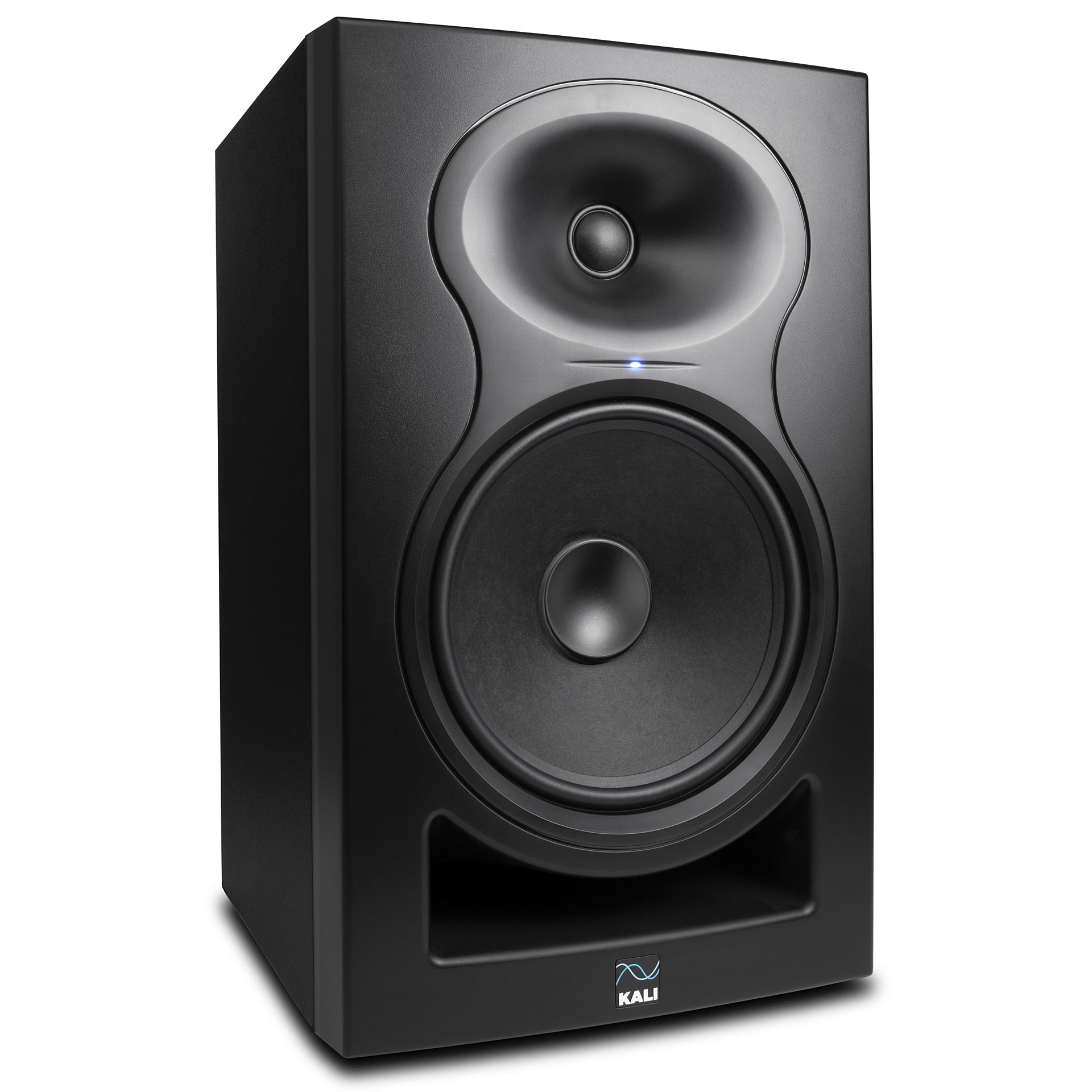
- Bass reflex system
- Power: 100 W (60 W / 40 W bi-amped)
- Frequency range: 37 – 25000 Hz
- Crossover frequency: 1500 Hz
- Sound pressure level: 85 dB SPL continuous
- Inputs: XLR, 6.3 mm jack (balanced), RCA
| IMAGE | PRODUCT | For US Customers |
For EU Customers |
Amazon Store |
|---|---|---|---|---|
Kali Audio LP-8 |
4. Focal Alpha 80
Focal’s Alpha 80 brings top-tier innovation to an affordable price point. It features two Class AB amplifiers, delivering 100 Watts to the low frequencies and 40 Watts to the high frequencies, for a total of 140 Watts. With a frequency response of 35Hz to 22kHz and a maximum sound pressure level of 109dB, this monitor provides more than enough power and clarity for studio use.
You can find detailed information about the Alpha 80’s design on the manufacturer’s website. The monitor measures 397mm in height, 287mm in width, and 348mm in depth, and it weighs 28.2 pounds. Its 15mm MDF enclosure includes a bass port, which allows flexible positioning. The monitor is equipped with an 8-inch Polyglass cone woofer and a 1-inch inverted dome tweeter.
We were very impressed with the Alpha 80’s sound quality. It delivered outstanding clarity and accuracy, faithfully reproducing every instrument in the mix without coloration. When we played our mixes on older speakers after using the Alpha 80, the sound remained flawless.
While there are noticeable design differences between the Alpha 80 and the Alpha 70, they both weigh the same at 28.2 pounds. In terms of audio quality, both the Alpha 80 and Shape 65 perform well, but the Shape 65 stands out in a different league. When compared, we found the Shape 65 offered even more detail and accuracy than the Alpha 80.
Overall, the Alpha 80 is an excellent 8-inch studio monitor. Its impressive highs and powerful lows deliver great sound quality, and its neutral character makes it a fantastic choice for anyone seeking a reliable 8-inch monitor.
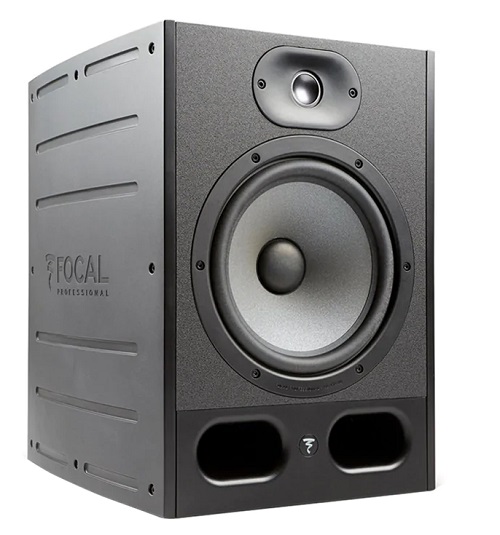
- Power Configuration: Bi-amped
- Quantity: Single
- LF Driver Size: 8″ Woofer
- HF Driver Size: 1″ Tweeter
- Total Power: 115W Class D
- Frequency Response: 38Hz-22kHz
Since Alpha 80 is upgraded to Alpha 80 Evo, the links below lead to the new and improved version of the speaker above!
| IMAGE | PRODUCT | For US Customers |
For EU Customers |
Amazon Store |
|---|---|---|---|---|
Focal Alpha 80 Evo |
And if you want to check the full review on the Alpha 80 Evo, follow this link here!
5. M-Audio BX8 D3
The M-Audio brand has been around for a long time and was once known as the go-to company for entry-level studio monitors. Although their quality dipped about a decade ago, their recent release of the BX series has helped them reclaim their place in the industry. Both professionals and beginners now rate them highly as a solid budget-friendly option.
Just like the JBL LSR series, the BX series has seen several updates, with the D3 being the third version. Compared to the previous D2 model, the D3 offers 150 Watts of power (80W LF, 70W HF) instead of 130 Watts, as well as a lower frequency response reaching down to 37 Hz instead of 56 Hz. The D3 also includes improved stereo imaging thanks to an optimized tweeter waveguide and new acoustic tuning controls.
Since the BX8 is a rear-ported monitor, it’s not ideal for placement near walls. However, if you’re tight on space, you can use the acoustic tuning switches to help minimize any issues. One standout feature is the bright alignment LED, which sets these monitors apart from competitors. The embedded LED in the cabinet shines brightest when the monitors are perfectly aligned with your listening position.
At first glance, these monitors might seem basic, but they offer everything you need to achieve a great listening position for sound shaping and mixing with confidence. We found that we could trust their sound quickly, and if your mix sounds good in the car, that’s usually a sign you’ve nailed it.
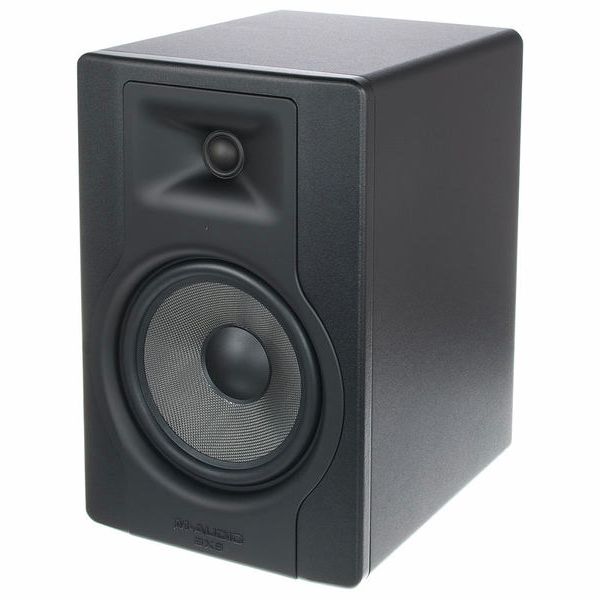
- Woofer: 8 “woofer (203 mm) 70 W with Kevlar membrane
- Amplifier: 150W RMS bi-amp Class A / B power amp
- Maximum level: 114 dB
- Crossover: 1900 Hz
- Further sound adjustments: Acoustic Space
- Frequency range: 37 – 22,000 Hz
| IMAGE | PRODUCT | For EU Customers |
|---|---|---|
M-Audio BX8 D3 |
6. ADAM Audio T8V
When designing the Adam Audio T8V monitor speakers, Adam Audio kept both studio owners and bedroom producers in mind. The T8V is the latest addition to their T-Series, featuring 8-inch woofers (compared to the 5-inch and 7-inch woofers found in the T5V and T7V models). Not only is the T8V physically larger and heavier than its siblings, but it’s also louder and delivers a wider frequency range.
The T8V is equipped with Adam Audio’s patented U-ART 1.9” ribbon tweeter at the top and an 8″ woofer at the bottom. These are active monitors, powered by two Class D amplifiers: a 20W amp for the U-ART tweeter and a 70W amp for the woofer.
Just like the T5V, the T8V impresses in terms of sound quality. The highs stay crisp and the mids remain clear, while the larger 8-inch woofer gives the low end extra punch. However, the frequency response does lean a bit more towards the bass compared to the A7X.
Because of its size, the T8V needs more desk and room space to perform at its best, but it offers a very satisfying mix of power and clarity. If you’re working with a smaller desk or a more compact space, the T5V is an excellent alternative.
Overall, the T8V monitors are a fantastic choice for engineers looking for reliable production monitors for both studio and home setups. We highly recommend them.
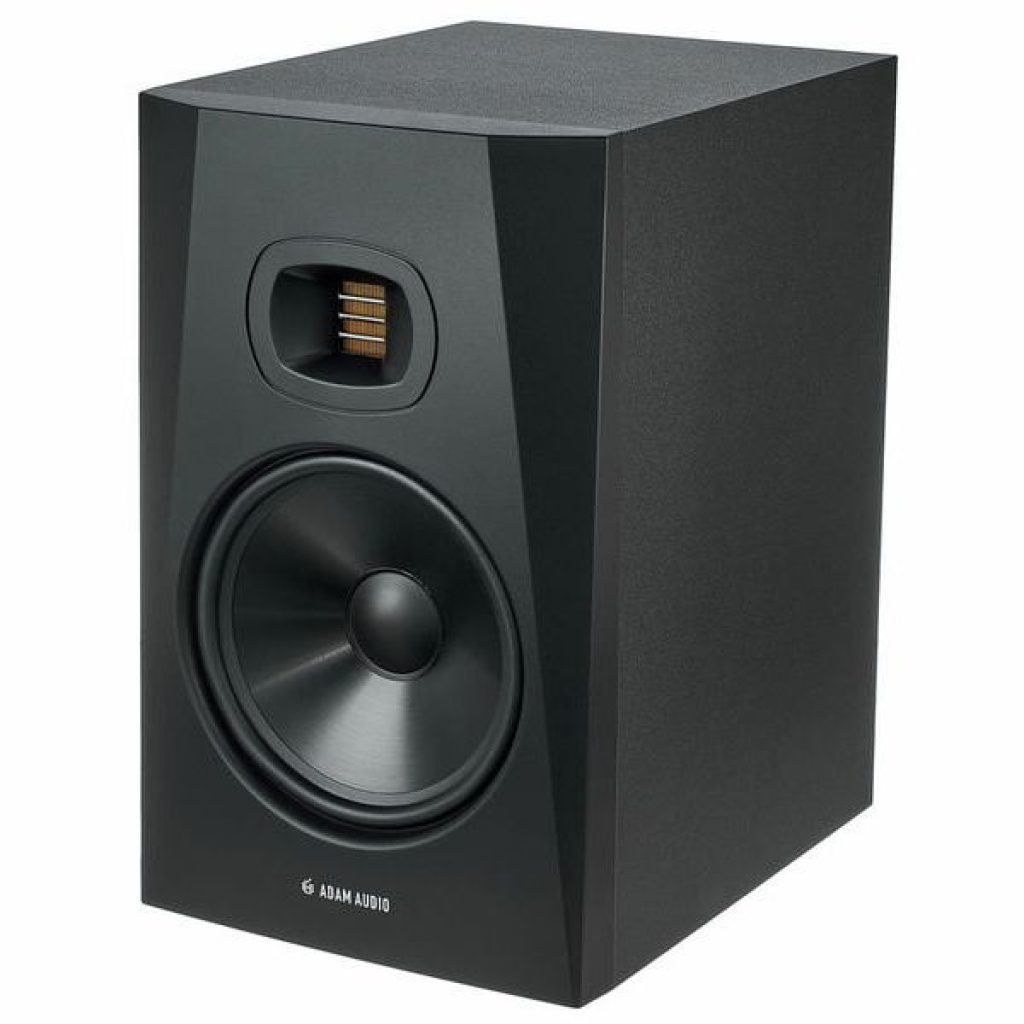
- 8″ Woofer
- 1.9″ U-ART Ribbon tweeter
- 2x Class-D amplifiers: 70 W RMS subwoofer, 20 W RMS tweeter
- Frequency response: 33 to 25,000 Hz
- Crossover frequency: 2600 Hz
- Max. SPL (sound pressure level): 118 dB (per pair at 1m)
| IMAGE | PRODUCT | For US Customers |
For EU Customers |
Amazon Store |
|---|---|---|---|---|
ADAM Audio T8V |
7. Genelec 8351B
We’ve already reviewed this fantastic pair of studio monitors, but let’s quickly highlight some of their features here. If you want the full in-depth review, you’ll find the link below.
The Genelec 8351B near-field monitor comes in a finish the manufacturer calls “producer.” Its standout design includes a coaxial driver and dual 8.6″ woofers, both perfectly aligned along their acoustic axes. This results in a single, precise point of sonic radiation for incredibly accurate sound.
The 8351B accepts both analog and digital AES/EBU signals via separate XLR jacks. It also features Intelligent Signal Sensing (ISS) technology, which detects when no audio is playing and automatically conserves energy. The monitor delivers a frequency response of 38 Hz to 20 kHz (±1.5 dB) and can hit a maximum SPL of 113 dB at 1 meter.
You can use Genelec’s GLM software to tune multiple 8351B monitors to your room, daisy-chain monitors together, or override the ISS function. GLM connectivity uses two RJ45 ports, with adapters and Cat5 (RJ45) cables for routing. Plus, an XLR output lets you connect other monitors to receive the same AES/EBU signal.
On the back, you’ll find DIP switches for offline level control and tuning—so you can adjust your monitors even without DSP. Each 8351B also comes with an Iso-Pod stand, which helps isolate the monitor from surfaces that might cause unwanted acoustic effects. Other highlights include Genelec’s acoustically concealed woofers, their minimal-diffraction coaxial design, and the proprietary waveguide for superior sound dispersion.
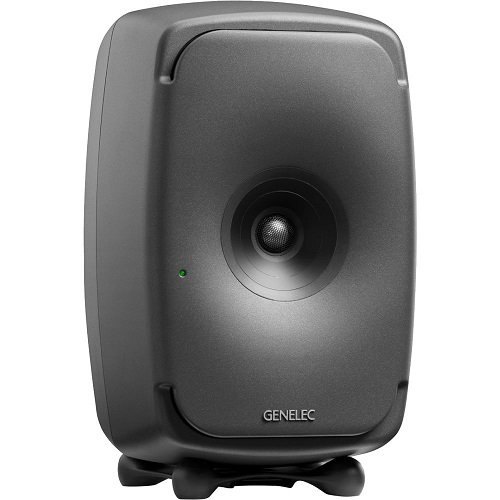
- Max. SPL: 113 dB
- Frequency response: 32 – 43000 Hz (-6 dB), 38 – 20000 Hz (± 1.5 dB)
- Analogue input: XLR
- AES/EBU input and output: XLR
- 2 RJ45 connectors
- Internal power supply 100-240 VAC 50/60Hz
| IMAGE | PRODUCT | For US Customers |
For EU Customers |
|---|---|---|---|
Genelec 8351B |
Check out our full review on the link here!
8. Dynaudio LYD 48
The Danish company Dynaudio is known for manufacturing high-quality loudspeakers for home audio, professional studio, and automotive markets. In 1992, Dynaudio launched its Professional division to develop monitor loudspeakers for recording studios and broadcasting. The company originally had its roots in the world of hi-fi. In the realm of professional monitors, Dynaudio’s BM series is especially popular and has been a favorite for many years.
On the rear panel of the Dynaudio LYD 48, you’ll find four switches for adjusting the speaker’s response. These include an IEC input, a power switch, an auto-standby mode switch, and an analog input (both balanced XLR and unbalanced RCA). However, Dynaudio believes that changes to the speaker’s response are rarely needed in actual use, so the LYD series offers relatively limited DSP adjustment options.
The LYD 48 features a Sound Balance switch with Bright and Dark options. The Bright setting uses a linear phase filter to boost the signal by 1.5dB at 20kHz and attenuate it by 1.5dB at 20Hz, reducing phase issues at the listening position. Selecting the Dark option swaps these frequency boosts and cuts.
The Dynaudio LYD 48 supports a 24-bit/96kHz digital audio signal format, uses a PWM Class D power amplifier, and includes a Dynaudio DSP module. The tweeter and woofer are powered by 50W and 80W amplifiers, respectively, while the midrange is powered by a 50W amplifier. The speakers offer a frequency response range from 32Hz to 21kHz.
Despite their reasonable price, these three-way active monitor speakers deliver excellent performance and quality. The LYD 48 is an affordable, high-performance choice for anyone seeking active monitor speakers.
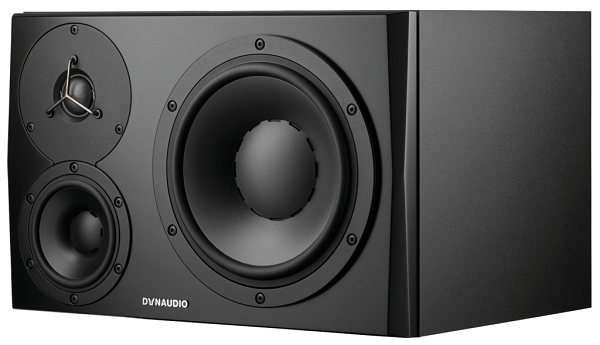
- 8″ Woofer
- 4″ Mid-range speaker
- 1″ Fabric tweeter
- Tri-Amp design class D amplifier
- Power: 50 / 50 / 80 Watt
- Frequency range: 40 – 21,000 Hz
| IMAGE | PRODUCT | For US Customers |
For EU Customers |
Amazon Store |
|---|---|---|---|---|
Dynaudio LYD 48 |
9. Mackie HR824mk2
As soon as you open the box, you’ll notice the curvy cabinet and glossy finish—gone are the angular edges of the past. The speaker is a bit heavier, and its size has increased slightly. This updated look not only brings the original 824’s design up to date, but also cleverly improves acoustics by reducing edge diffraction.
The low-frequency driver has grown slightly (now 8.75 inches instead of 8 inches), so you might think the HR824 mk2 uses the same drivers, since the proportions are similar. The 1-inch high-frequency driver is surrounded by waveguides that are about the same size and shape as those on the original 824.
Enhanced specs and bigger dimensions are thanks to a new passive woofer mounted behind the power amplifier assembly. On the back panel, a recessed slot holds the two IEC sockets and three input options (XLR, TRS, RCA).
Because all the cables are plugged in vertically, you can install the speaker right up against a wall without any connectors sticking out beyond the cabinet.
There are three controls on the rear panel: input sensitivity, an acoustic space selector (corner placement at -4dB, against the wall at -2dB, or normal for freestanding), which adjusts the low-frequency output.
You can also choose from three options for low-frequency bass management: 80Hz (THX standard), 47Hz (for use with any other subwoofer), and 37Hz (normal). As a follow-up to the acclaimed HR824 mk1, the HR824 mk2 stands out as a solid and reliable studio monitor.
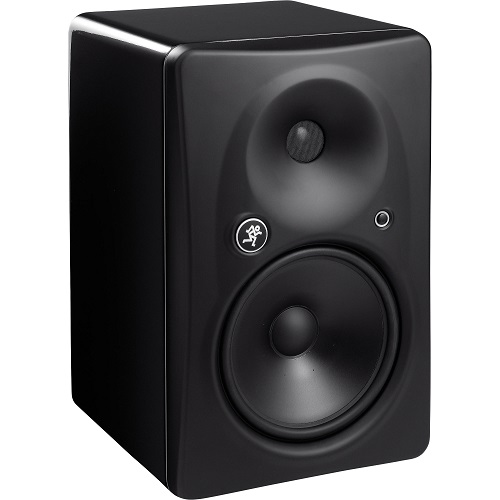
- Power Configuration: Bi-amped
- Quantity: Single
- LF Driver Power Amp: 150W
- HF Driver Power Amp: 100W
- Total Power: 250W
- Frequency Range: 37Hz-20kHz (±1.5 dB)
| IMAGE | PRODUCT | For US Customers |
Amazon Store |
|---|---|---|---|
Mackie HR824mk2 |
10. PreSonus R80 V2
With the R80 V2, Presonus introduces a larger studio monitor that delivers high-fidelity audio with a clear and powerful response—ideal for analyzing, mixing, and mastering your music. The 8″ custom-coated, woven composite low-frequency driver produces an accurate frequency response and transparent sound, thanks to its specially designed cone shape.
The R80 V2 is equipped with a custom-made Air Motion Transformer (AMT) tweeter, ensuring that high frequencies are reproduced with exceptional detail and precision. The unique housing of the AMT tweeter focuses the highs on the horizontal axis, pushing air and enhancing clarity in the high end. This design minimizes unwanted sound reflections from your furniture, ceiling, and floor, resulting in gentle vertical sound dispersion.
On the back panel, you’ll find controls that make the R80 V2 truly versatile. Easily boost or cut frequencies by up to 6dB with a simple knob, and fine-tune your levels with the Gain control.
The Acoustic Space and Low Cutoff controls provide even more flexibility, offering Flat, 80Hz, and 100Hz cutoff options, as well as -4dB, -2dB, and 0dB cut settings. These features help you tailor the R80 V2’s sound to perfectly suit your workspace. No matter where you use it, the R80 V2 is equipped to deliver peak performance with its range of sound-shaping tools.
Thanks to its bi-amped design, the LF driver (75W) and the high-frequency tweeter (65W) share a powerful 140W of Class D output—putting it among the top performers in its class. The Presonus R80 V2 also offers balanced XLR and 1/4″ TRS inputs, along with an unbalanced RCA input for connecting to audio interfaces, mixers, and more. With its transparent output, it’s a reliable choice for mixing, mastering, and much more.
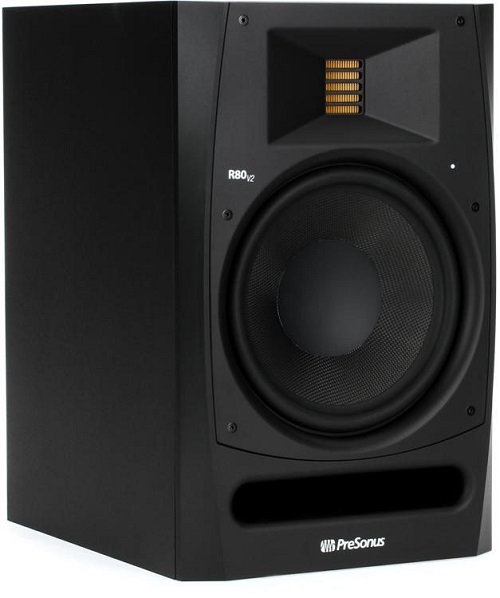
- 2-Way monitor with Air Motion ribbon tweeter
- 8″ Woofer made of composite fabric
- Tweeter with ultra-thin Kapton diaphragm (<0.01 mm)
- Tweeter area: 4.4 cm2
- Frequency response: 40 – 22000 Hz
- Crossover frequency: 2.6 kHz
| IMAGE | PRODUCT | For US Customers |
For EU Customers |
Amazon Store |
|---|---|---|---|---|
PreSonus R80 V2 |
11. ADAM Audio A8X
Next up, we have the ADAM Audio A8X from Germany. Known for delivering top-tier pro audio equipment, ADAM has been a major player since 1999. With years of research and development poured into every driver, ADAM focuses solely on studio monitors, allowing them to dedicate all their resources to creating the best possible products.
It’s clear at first glance that ADAM’s AX monitors are not your average speakers. They take Dr. Oskar Heil’s air motion transformer technology to the next level with their signature X-ART tweeter.
Thanks to this transformer, the loudspeaker can move faster and more accurately, resulting in superb fidelity. Its advanced power and dispersion features mean the A8X works equally well as a near-field or a midfield monitor.
When it comes to features, the A8X stands strong alongside the best studio monitors out there. The front-ported woofer design lets you place it closer to walls, and there are several tuning options to ensure balanced monitoring in all kinds of acoustic environments.
You get a low shelf EQ with a 6 dB boost or cut at 300 Hz, a high shelf EQ with 6 dB adjustment at 5 kHz, and an independent tweeter gain control with a 4 dB range. For a complete list of features and specs, check out the ADAM Audio website.
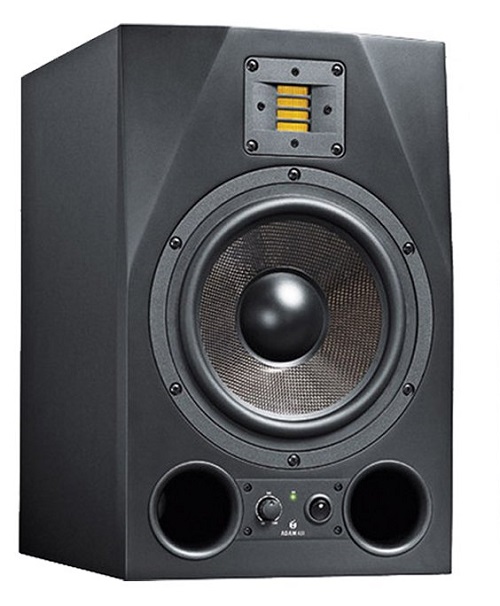
- German Handmade Precision X-ART Tweeter
- 8.5“ Woofer (Carbon/Rohacell/Glass Fiber)
- Amp. Power RMS / Music: 200 W / 300 W
- Frequency Response: 38 Hz – 50 kHz (-10 dB)
- Max. SPL per pair at 1 m: ≥120 dB
| IMAGE | PRODUCT | For US Customers |
|---|---|---|
ADAM Audio A8X |
8 Inch Studio Monitors: How to Choose the Best
No guide would be complete without discussing what to look for when choosing the best 8-inch studio monitors. There are several important factors to consider, since these monitors are designed to reproduce audio as accurately as possible.
Range and Response of Frequencies
These two important specifications are sometimes used interchangeably by some manufacturers, but it’s important to understand the difference between them. As the term suggests, frequency range refers to the span of frequencies that the monitors can reproduce. Any specification with a higher or lower limit might not matter much, since human hearing typically falls between 20 Hz and 20 kHz.
More specifically, a monitor’s frequency response describes how it alters the audio signal during playback. This is usually shown as a curve, with the X-axis representing the range of frequencies and the Y-axis showing the gain in dB. By looking at the curve, you can see where the audio signal is being boosted or cut across the spectrum. Ideally, you want to find a speaker with a flat frequency response, and this graph is what you should check to find it.
Unported vs Ported
Ported studio monitors typically offer a wide frequency range, but this comes at the cost of some accuracy and flexibility in placement. Because of the port’s resonance frequency, the monitor’s natural bass roll-off begins just below this point.
On the other hand, unported monitors generally have a less steep and tighter bass roll-off. They are also better at reproducing low-frequency transients, often described as “tight” bass. Without a port to create a resonance peak, transients remain clear and are not blurred.
Selecting Materials
Choosing the right cabinet material is crucial. MDF is an excellent option because it is homogeneous and free of voids. This makes it ideal for ensuring accurate sound. Solid wood, with its higher density compared to lighter, less sturdy materials, also helps reduce resonances. For the most accurate monitoring, MDF minimizes coloration of the sound.
Build and Design of Drivers
A studio monitor is made up of two types of speakers: a woofer and a tweeter. Woofers are the larger drivers that handle low frequencies, while tweeters are smaller and produce high frequencies. Some midfield and far-field monitors also include a dedicated mid-range driver.
When we talk about a monitor’s size—such as 5 inches or 8 inches—we’re actually referring to the diameter of the woofer cone. In general, larger woofers tend to provide better bass response.
Types of Amplifiers and Bi-amplifiers
Monitor speakers come with built-in amplifiers that are important to consider. All of the monitors listed here are active monitors. This means these speakers are powered and have their own individual power amplifiers inside.
Because they need electricity to work, it makes sense that they require a power source. If you want to use passive monitors or passive speakers, you will also need other equipment in your setup, such as external power amplifiers.
Conclusion
When choosing studio monitors, you should look for models with a flat frequency response to ensure the most uncolored and accurate sound possible. All the studio monitors on our list are great for studio use, offering this feature and delivering precise audio. Just keep in mind that completely flat frequency response doesn’t exist—you’ll need to find the monitor that suits your needs best.
It’s difficult to recommend a single “best” studio monitor, as the choice depends heavily on your intended use and personal preferences as an engineer. However, from our list, the Genelecs 8351B stand out for professional use and higher budgets, while the Adam T8V is a solid, affordable choice for home studios.
Good luck with your search for the perfect studio monitor! If you have any questions about this topic or need advice about any of the models we mentioned, please leave a comment below—we’re happy to help!

